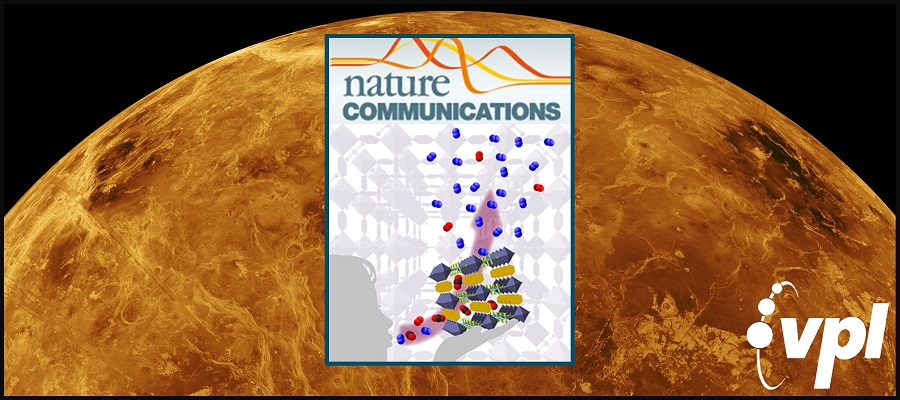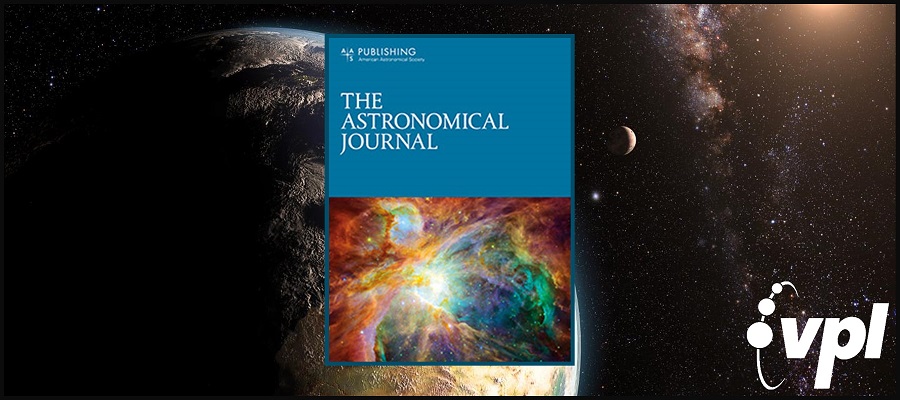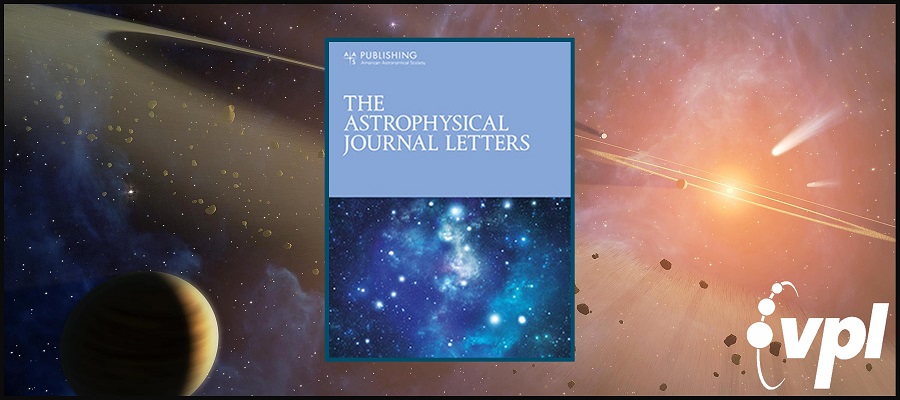VPL Postdoctoral Researcher, Andrew Lincowski (University of Washington), and VPL project PI, Victoria Meadows (University of Washington), published two new…
Point-source spectrophotometric (single-point) light curves of Earth-like planets contain a surprising amount of information about the spatial features of those worlds. Spatially resolving these light curves is important for assessing time-varying surface features and the existence of an atmosphere, which in turn is critical to life on Earth and significant for determining habitability on exoplanets. Given that Earth is the only celestial body confirmed to harbor life, treating it as a proxy exoplanet by analyzing time-resolved spectral images provides a benchmark in the search for habitable exoplanets. The Earth Polychromatic Imaging Camera (EPIC) on the Deep Space Climate Observatory (DSCOVR) provides such an opportunity, with observations of ~5000 full-disk sunlit Earth images each year at 10 wavelengths with high temporal frequency. We disk-integrate these spectral images to create single-point light curves and decompose them into principal components (PCs). Using machine-learning techniques to relate the PCs to six preselected spatial features, we find that the first and fourth PCs of the single-point light curves, contributing ~83.23% of the light-curve variability, contain information about low and high clouds, respectively. Surface information relevant to the contrast between land and ocean reflectance is contained in the second PC, while individual land subtypes are not easily distinguishable (<0.1% total light-curve variation). We build an Earth model by systematically altering the spatial features to derive causal relationships to the PCs. This model can serve as a baseline for analyzing Earth-like exoplanets and guide wavelength selection and sampling strategies for future observations.
VPL Researcher Tyler Robinson (Northern Arizona University) was recently named as one of the 25 recipients of the 2021 Cottrell Scholar Award!…
The abundance of SO dimers (SO)2 in the upper atmosphere of Venus and their implications for the enigmatic ultraviolet absorption has been investigated in several studies over the past few years. However, the photochemistry of sulfur species in the upper atmosphere of Venus is still not well understood and the identity of the missing ultraviolet absorber(s) remains unknown. Here we update an existing photochemical model of Venus’ upper atmosphere by including the photochemistry of SO dimers. Although the spectral absorption profile of SO dimers fits the unknown absorber, their abundance is found to be too low for them to contribute significantly to the absorption. It is more likely that their photolysis and/or reaction products could contribute more substantively. Reactions of SO dimers are found to be important sources of S2O, and possibly higher order SnO species and polysulfur, Sn. All of these species absorb in the critical ultraviolet region and are expected to be found in both the aerosol and gas phase. indicating that in-situ high resolution aerosol mass spectrometry might be a useful technique for identifying the ultraviolet absorber on Venus.
Point source spectrophotometric (“single-point”) light curves of Earth-like planets contain a surprising amount of information about the spatial features of those worlds. Spatially resolving these light curves is important for assessing time-varying surface features and the existence of an atmosphere, which in turn is critical to life on Earth and significant for determining habitability on exoplanets. Given that Earth is the only celestial body confirmed to harbor life, treating it as a proxy exoplanet by analyzing time-resolved spectral images provides a benchmark in the search for habitable exoplanets. The Earth Polychromatic Imaging Camera (EPIC) on the Deep Space Climate Observatory (DSCOVR) provides such an opportunity, with observations of ~5000 full-disk sunlit Earth images each year at ten wavelengths with high temporal frequency. We disk-integrate these spectral images to create single-point light curves and decompose them into principal components (PCs). Using machine learning techniques to relate the PCs to six preselected spatial features, we find that the first and fourth PCs of the single-point light curves, contributing ~83.23% of the light curve variability, contain information about low and high clouds, respectively. Surface information relevant to the contrast between land and ocean reflectance is contained in the second PC, while individual land sub-types are not easily distinguishable (<0.1% total light curve variation). We build an Earth model by systematically altering the spatial features to derive causal relationships to the PCs. This model can serve as a baseline for analyzing Earth-like exoplanets and guide wavelength selection and sampling strategies for future observations.
Dr. Michael Wong was interviewed by the Nexus for Exoplanet System Science (NExSS) Science Communication Working Group to be featured…
The orbital architecture of the solar system is thought to have been sculpted by a dynamical instability among the giant planets. During the instability a primordial outer disk of planetesimals was destabilized and ended up on planet-crossing orbits. Most planetesimals were ejected into interstellar space, but a fraction were trapped on stable orbits in the Kuiper Belt and Oort cloud. We use a suite of N-body simulations to map out the diversity of planetesimals’ dynamical pathways. We focus on two processes: tidal disruption from very close encounters with a giant planet, and loss of surface volatiles from repeated passages close to the Sun. We show that the rate of tidal disruption is more than a factor of 2 higher for ejected planetesimals than for surviving objects in the Kuiper Belt or Oort cloud. Ejected planetesimals are preferentially disrupted by Jupiter and surviving ones by Neptune. Given that the gas giants contracted significantly as they cooled but the ice giants did not, taking into account the thermal evolution of the giant planets decreases the disruption rate of ejected planetesimals. The frequency of volatile loss and extinction is far higher for ejected planetesimals than for surviving ones and is not affected by the giant planets’ contraction. Even if all interstellar objects were ejected from solar system–like systems, our analysis suggests that their physical properties should be more diverse than those of solar system small bodies as a result of their divergent dynamical histories. This is consistent with the characteristics of the two currently known interstellar objects.
Mantle convection and, by association, plate tectonics is driven by the transport of heat from a planetary interior. This heat comes from the internal energy of the mantle and from heat flowing into the base of the mantle from the core. Past investigations of such mixed mode heating have revealed unusual behavior that confounds our intuition based on end?member cases. In particular, increased internal heating leads to a decrease in convective velocity. We investigate this behavior using a suite of numerical experiments and develop a scaling for velocity in the mixed heating case. We identify a planform transition, as internal heating increases, from sheet?like to plume?like downwellings that impacts heat flux and convective velocities. More significantly, we demonstrate that increased internal heating leads not only to a decrease in internal velocities but also a decrease in the velocity of the upper thermal boundary layer (a model analog of the Earth’s lithosphere). This behavior is connected to boundary layer interactions and is independent of any particular rheological assumptions. In cases with a temperature?dependent viscosity and weak plate margin analogs, increased internal heating does not cause an absolute decrease in surface velocity but does cause a decrease relative to purely bottom or internally heated cases as well as a transition to rigid?lid behavior at high heating rates. The differences between a mixed system and end?member cases have implications for understanding the connection between plate tectonics and mantle convection and for planetary thermal history modeling.
Deputy PI and Task B Co-Lead, Giada Arney, and one of the VPL team’s resident Venus experts, was recently honored…
An episode of dynamical instability is thought to have sculpted the orbital structure of the outer solar system. When modeling this instability, a key constraint comes from Jupiters fifth eccentric mode (quantified by its amplitude ), which is an important driver of the solar systems secular evolution. Starting from commonly-assumed near-circular orbits, the present-day giant planets architecture lies at the limit of numerically generated systems, and is rarely excited to its true value. Here we perform a dynamical analysis of a large batch of artificially triggered instabilities, and test a variety of configurations for the giant planets primordial orbits. In addition to more standard setups, and motivated by the results of modern hydrodynamical simulations of the giant planets evolution within the primordial gaseous disk, we consider the possibility that Jupiter and Saturn emerged from the nebular gas locked in 2:1 resonance with non-zero eccentricities. We show that, in such a scenario, the modern JupiterSaturn system represents a typical simulation outcome, and is commonly matched. Furthermore, we show that Uranus and Neptunes final orbits are determined by a combination of the mass in the primordial Kuiper belt and that of an ejected ice giant.
Paleo?temperature data indicates that the Earth’s mantle has not cooled at a constant rate. The data show slow cooling from 3.8 to 2.5?Ga followed by more rapid cooling until the present. This has been argued to indicate a transition from a single plate mode to a plate tectonics. However, a tectonic change may not be necessary. Multistage cooling can result from deep water cycling coupled to mantle convection. Melting and volcanism removes water from the mantle (degassing). Dehydration tends to stiffen the mantle, which slows convective vigor and plate velocities causing mantle heating. Higher mantle temperature tends to lower mantle viscosity and increase plate velocities. If these two tendencies are in balance, then mantle cooling can be weak. Breaking this balance, via a switch to net mantle rehydration, can cool the mantle more rapidly. We use coupled water cycling and mantle convection models to test the viability of this hypothesis. Within model and data uncertainty, the hypothesis that deep water cycling can lead to a multi?stage Earth cooling is consistent with data constraints. Probability distributions, for successful models, indicate that plate and plate margin strength play a minor role for resisting plate motions relative to the resistance from interior mantle viscosity.
Here, we present the results of a study that explores the effect of Jupiter’s location on the orbital parameters of Venus and subsequent potential water-loss scenarios. Our dynamical simulations show that various scenarios of Jovian migration could have resulted in orbital eccentricities for Venus as high as 0.31. We quantify the implications of the increased eccentricity, including tidal energy, surface energy flux, and the variable insolation flux expected from the faint young Sun. The tidal circularization timescale calculations demonstrate that a relatively high tidal dissipation factor is required to reduce the eccentricity of Venus to the present value, which implies a high initial water inventory.
Giada Arney works at NASA Goddard Space Flight Center and as part of the VPL team is the Project Deputy…
Are we alone in the universe? How did life arise on our planet? How do we search for life beyond…
Orbiter and rover data have revealed a complex and intermittent hydrological history in Gale Crater on Mars, where habitable environments appear to have endured for at least thousands of years. The intermittency may be the result of a dominantly cold climate punctuated by geologically brief periods of warmth and active hydrology. However, the time required to establish an integrated hydrological cycle in a warming climate is difficult to ascertain and has not been thoroughly investigated. Here we model the transient evolution of groundwater flow and subsurface temperature, the slowest evolving components of the hydrological cycle, during a warm departure from cold conditions. We find that tens of thousands of years are likely required before groundwater could be a meaningful source for large lakes in Gale. With highly favorable conditions, primarily high permeability, significant flow might develop in thousands of years. This implies that surface water dominates during the beginning of a warm phase. Annual mean surface temperatures in Gale below 290?K would likely leave the nearby highlands frozen at the surface. In that case, deep aquifers beneath a highlands permafrost layer could deliver water to Gale, where low temperatures would have reduced evaporation.
We present a study of the photochemistry of abiotic habitable planets with anoxic CO2–N2 atmospheres. Such worlds are representative of early Earth, Mars, and Venus and analogous exoplanets. Photodissociation of H2O controls the atmospheric photochemistry of these worlds through production of reactive OH, which dominates the removal of atmospheric trace gases.
A major focus of astrobiology is the search for habitable conditions and life beyond Earth. We have scrutinized Earth intensely to understand how we might search for habitable conditions elsewhere. In many ways, Venus is the most Earth-like planet in the solar system with its similar mass, radius, and bulk density. Indeed, it is likely that Venus and Earth had very similar starting conditions in terms of their relative compositions of both volatiles and refractory compounds. Yet Earth has been habitable since at least the start of the Archean geological eon (about 3.8 b.y. ago) and possibly during the Hadean…
Astrobiology is intended to be the science of life in the cosmos. When fully developed it will encompass the origins of life and all of lifes manifestations in the full variety of astrophysical environments in which it will be found. It is a big picture, but with one exception it is all future conditional. This is why one begins a book on planetary astrobiology with Earth: Earth is our only known role model for how to succeed in the cosmos. This chapter explores the processes involved in planet formation and which of them may play important roles in establishing the…
Are we alone in the universe? How did life arise on our planet? How do we search for life beyond Earth? These profound questions excite and intrigue broad cross sections of science and society. Answering these questions is the province of the emerging, strongly interdisciplinary field of astrobiology. Life is inextricably tied to the formation, chemistry, and evolution of its host world, and multidisciplinary studies of solar system worlds can provide key insights into processes that govern planetary habitability, informing the search for life in our solar system and beyond. Planetary Astrobiology brings together current knowledge across astronomy, biology, geology, physics, chemistry, and related fields, and considers the synergies between studies of solar systems and exoplanets to identify the path needed to advance the exploration of these profound questions.
Planetary Astrobiology represents the combined efforts of more than seventy-five international experts consolidated into twenty chapters and provides an accessible, interdisciplinary gateway for new students and seasoned researchers who wish to learn more about this expanding field. Readers are brought to the frontiers of knowledge in astrobiology via results from the exploration of our own solar system and exoplanetary systems. The overarching goal of Planetary Astrobiology is to enhance and broaden the development of an interdisciplinary approach across the astrobiology, planetary science, and exoplanet communities, enabling a new era of comparative planetology that encompasses conditions and processes for the emergence, evolution, and detection of life.
The quest for both habitable and inhabited worlds beyond Earth is key to understanding the potential distribution of life in the universe. This ongoing search seeks to answer profound questions: Are we alone? How unique is Earth? Should the hunt for life beyond Earth uncover a multitude of habitable worlds and few (if any) inhabited ones, humanity would begin to understand just how lonely and fragile our situation is. On the other hand, if our hunt yields a true diversity of inhabited worlds, then we would learn something fundamental about the tenacity of life in the cosmos.
Full Citation: Meadows V. S., Arney G. N., Des Marais D. J., and Schmidt B. E. (2020). Preface. In Planetary…
Enceladus, a small moon in orbit around Saturn, has been full of surprises since it was first identified in 1789. The discovery of Enceladus is credited in part to William Herschel, who was fortuitously observing Saturn at equinox. During equinox, the Sun and Earth are aligned edge-on with the rings of Saturn, reducing the observed reflection of sunlight off the rings (ringshine), which is usually bright enough to mask Enceladus from most telescopes. Enceladus is named after one of the Titans, giants in Greek mythology, and contrary to its small size (504 km or 313 miles in diameter), it has…
The discovery of extrasolar planets demonstrated that the current solar system-inspired paradigm of planet formation was on the wrong track. Most extrasolar systems bear little resemblance to our well-ordered solar system. While the solar system is radially segregated by distance from the star, with small inner rocky worlds and more distant giant planets, few known exo-systems follow the same blueprint. Models designed with the goal of reproducing the solar system failed spectacularly to understand why other planetary systems looked different than our own.
Yet exoplanets represent a huge sample of outcomes of planet formation, and new ideas for solar system…
Strong seismic waves from the July 2019 Ridgecrest, California, earthquakes displaced rocks in proximity to the M 7.1 mainshock fault trace at several locations. In this report, we document large boulders that were displaced at the Wagon Wheel Staging Area (WWSA), approximately 4.5 km southeast of the southern terminus of the large M 6.4 foreshock rupture (hereafter “the large foreshock”) and 9 km southwest of the nearest approach of the M 7.1 mainshock surface rupture
A key factor in determining the potential habitability of synchronously rotating planets is the strength of the atmospheric boundary layer inversion between the dark side surface and the free atmosphere. Here we analyze data obtained from polar night measurements at the South Pole and Alert Canada, which are the closest analogs on Earth to conditions on the dark sides of synchronously rotating exoplanets without and with a maritime influence, respectively. On Earth, such inversions rarely exceed 30 K in strength, because of the effect of turbulent mixing induced by phenomena such as so-called “mesoscale slope winds,” which have horizontal scales of 10100 s of km, suggesting a similar constraint to near-surface dark side inversions. We discuss the sensitivity of inversion strength to factors such as orography and the global-scale circulation, and compare them to a simulation of the planet Proxima Centauri b. Our results demonstrate the importance of comparisons with Earth data in exoplanet research, and highlight the need for further studies of the exoplanet atmospheric collapse problem using mesoscale and eddy-resolving models.








